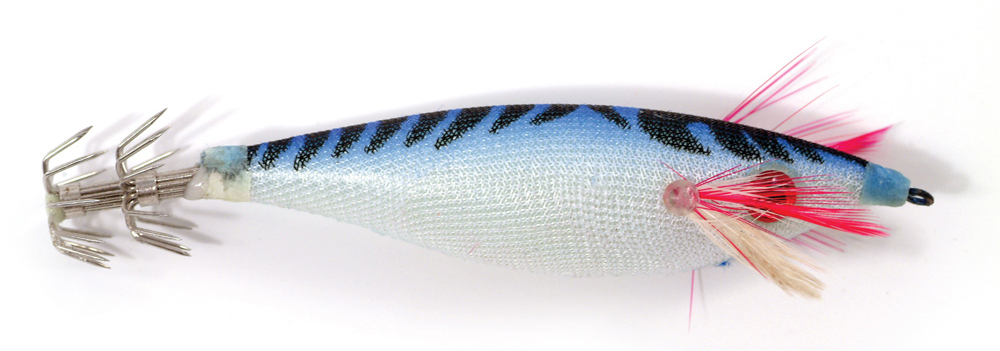If you're going fishing overnight somewhere like Baltimore Canyon and you want to know how to catch squid, we just want you to remember that these critters have eight arms, two tentacles, hundreds of tiny suction cups, a sharp beak, and an exceptionally bad attitude when hoisted out of the brine and into a boat. And no, these feisty creatures are not normally what one targets when investing countless hours of preparation and thousands of dollars in expenses to spend a night at the edge of the Continental Shelf. But catching squid is such an unusual angling experience – and so downright entertaining – that anyone who does make the effort to overnight at the canyons should make dang sure there are squid jigs aboard the boat. And when the bigeye tuna and swordfish aren’t cooperating, a flock of squid swarming around you can save the day. Errr, night. Calamari, anyone?
Squid Fishing at Night
Lest you enter this endeavor thinking that the shortfin squid living along the canyon edges of the Mid-Atlantic region are harmless, squishy, defenseless little goo-balls, be aware that they are armed with a parrot-like beak. They can and will draw blood if you’re not careful. And it’s very difficult to be careful when there’s a squid-fest going on, thanks to this creature’s other defense mechanism: wildly squirting a mix of seawater and ink in every direction. When a squid comes up spitting, the general reaction aboard is usually lots of hooting, hollering, and laughing – whether you’re the one being blasted or you see a buddy take a direct hit in the face. Tilting the squid in one direction or another makes it possible to initiate a water-gun battle of sorts, and when a bunch of anglers start pointing weaponized cephalopods at one another at two o’clock in the morning, caution does indeed go into the wind – prepare to be bitten.
Fortunately, the startle from being chomped on by a squid beak is far bigger than the actual injury. The worst squid wounds are on the level of a pin-prick and the most significant casualty is usually pride – in this case, heartlessly laughing at the injured party is completely within bounds.
The key to catching squid lies in gearing up properly. People will say you can catch them by tying a tiny hook on a light line and using a sliver of bait, and this is true, but consider yourself lucky to boat two or three squid a night using this method. Serious calamari lovers will want to load a cooler and to accomplish this, you need a proper squid jigging rig.
Squid Jigs

Squid jigs aren’t found in every tackle shop and those that do carry them rarely have a wide selection, so it’s smart to hunt down a handful of them well in advance of an overnighter. They’re most effective when rigged in tandem, on four- to five-inch leaders a foot or so above a one- to three-ounce weight. If you can find a lead-body squid jig to use as the weight, so much the better. In the Mid-Atlantic region, two- to three-inch jigs in pinks and blues usually seem best. Make sure you carry enough to make up a rig for everyone aboard – regardless of what someone may say at the dock they’re bound to get caught up in the fun and reach for a rod when squid start coming over the gunwales – plus several extras. Fish will occasionally grab a squid rig and the end result is usually a break-off, so replacements will likely be needed.
To get the squid off the jig, simply suspend it over either the livewell or a cooler, hold the jig by its body, invert it, and give a shake. But be careful not to shake the squid off directly onto your hand, which commonly results in everyone aboard laughing at your surprised shrieks as the squid’s beak pierces your skin.
Since there is so much time, effort, and expense involved with overnighting offshore, most people who try squidding do it in-between bites while targeting swords or tunas. The good news is that you don’t have to go looking for squid, because if you’re in an area where these predators are you’ll usually find squid as well. Often the squid will give away their presence by zipping through the boat’s fishing lights, and if you’re chunking, they’ll commonly swim up and grab bits and pieces of the cut fish as you toss them overboard. In this case tossing the squid jigs a few yards from the boat and jigging them along the surface is often effective.
Squid Jigging Tips
Quite commonly you’ll see a squid here and there but the main body of the school will remain out of sight, just outside the lighted water. When they seem a bit shy, jigging 20 to 30 feet beneath the boat usually does the trick. And on occasion you’ll never see a squid near the surface but big blobs on the fishfinder, 50 or even 100 feet deep, will give away their presence.
In all of these cases, the most effective jigging technique is usually a relatively slow sweep up with the rod, followed by allowing the rig to fall while slowing it just enough to keep minimum tension. Most of the time the squid will attack as the jig falls, and when you start sweeping the rod tip back up you’ll feel extra weight. There’s no need to set the hook thanks to those baskets, but do your best to apply constant tension so the squid can’t free itself. They’ll fight more or less like a similarly-sized fish, right up until you swing them into the boat and cephalopodic chaos breaks out.

When squid are present around the boat and they all simultaneously dart off, crank in your squid jig rods asap and set them aside. The fleeing squid is a sure sign a serious predator has showed up, and it’s time to be prepared for a swordfish or tuna strike.
Calamari lovers will be tempted to toss each and every squid into the cooler, but savvy anglers will sacrifice a few and swap out the bait on a couple of chunk or float lines with a live squid – any predators passing by won’t be able to resist attacking them. Running a single hook through the tip of the squid’s mantle and setting the squid right at the edge of the light-line, where your fishing lights fade out into the darkness, is usually the best bet. Set the reel to freespool, clicker on, and engage the drag as quickly as possible when there’s a strike.